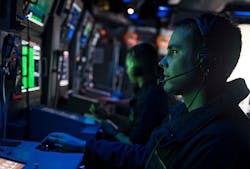Navy to brief industry next week on information warfare, cloud computing, and network security
Officials of the Space and Naval Warfare Systems Command (SPAWAR) Systems Center-Atlantic in North Charleston, S.C., issued a presolicitation (N65236-18-R-T001) Tuesday for the Information Warfare Research Project (IWRP) Industry Day and Upcoming Prototype Projects.
The industry briefings next week involve an upcoming request for prototype projects, which will be issued to the Navy’s new Information Warfare Research Project (IWRP) Consortium, which is run by Advanced Technology International in Summerville, S.C.
Briefings will involve the SPAWAR Organization, Other Transaction Authority (OTA), IWRP, consortium operations, presentation of technical briefs, and one-on-one breakout sessions.
Related: The shadowy world of cyber warfare
These briefings will zero-in on five topics, which will be the basis of upcoming request for prototype projects to IWRP Consortium members: universal cloud infrastructure deployment capability; covert direction finding; Goose Sensor System; enterprise network & internal private cloud; and network and data security.
Universal cloud infrastructure deployment capability seeks to develop a prototype rapidly to develop a commercial service provider (CSP) agnostic write-once/deploy-many type capability, in an agile software development framework.
This will enable developers to code description of virtual networks, hosts, load balancers, and virtual protocol networks (VPNs) in one location and have CSP specific classes translate the environment and call on CSP's specific application programming interfaces to deploy environment to one or several concurrent cloud providers.
Covert direction finding involves a prototype that produces a low-profile body-worn direction finding capability that can provide accurate lines of bearings for find, fix, and finish operations, as well as electro-magnetic spectrum situational awareness.
Related: Today's battle for the electromagnetic spectrum
Goose Sensor System involves a prototype to enhance survivability and provide force multiplication to the expeditionary warfighter. Previously, the U.S. Marine Corps left a man behind to ensure that previously cleared rooms in a building remained empty. The Goose Sensor System will enable the warfighter to deploy a small passive infrared sensor to provide remote alerts of room breaches.
Enterprise network & internal private cloud seeks to develop a prototype to create an enterprise network that links several independent and geographically separate work centers. The prototype will use a multi-site, multi-tenant internal private cloud that uses software-defined networking to automate network operations.
This has the potential to minimize manpower to operate the network; provide seamless workload mobility between work centers; enable one user at one work center to use computing resources at another work center gain access to the Internet at another work center; and create a two-location global network operations center that will operate and maintain the enterprise network and private cloud.
Related: The importance of military information security
Network and data security will look to receive prototypes that provide network and security for safeguarding covered defense information and controlled unclassified information held by contractors and incident reporting.
Navy researchers want this prototype to help meet or exceed current federal requirements to safeguard covered defense information and controlled unclassified information, report adverse security incidents, and assure compliance of contractors and subcontractors without an increase in cost or oversight. Details be released with the upcoming request for prototype projects and its related statements of work.
Companies interested can register for the industry briefings online at https://events.bizzabo.com/209677. More information is online at https://www.fbo.gov/notices/c330cfbf457e72942e17df4f8a999a63.
Ready to make a purchase? Search the Military & Aerospace Electronics Buyer's Guide for companies, new products, press releases, and videos
